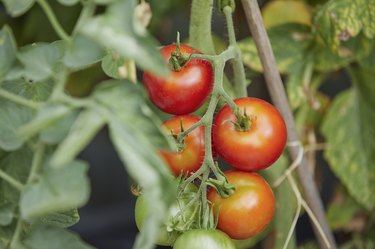
Like any other fruit-bearing plant, tomatoes (Solanum lycopersicum) need water in order to produce a crop. However, simply watering tomatoes is not enough; taking rainfall into account to make sure that the tomato plants receive consistent moisture throughout the growing season is just as important, especially around the time the tomatoes are ripening. Inconsistent watering at this time can cause the fruit to crack and split.
Water for Tomatoes
Video of the Day
A tomato is made up of 95 percent water. A tomato plant typically requires about an inch of water a week from rainfall or irrigation. Tomato plants not only need water to produce quality fruit but they also need proper watering to develop strong root systems that can sustain that fruit. Therefore, when watering tomatoes, it is important to water the plants deeply rather than just the first inch or two of soil.
Video of the Day
The amount of water a tomato plant requires will also vary according to the type of soil in which they are grown. Sandy soils through which water moves quickly will require more watering than heavier clay soils. Tomatoes grown in containers may need to be watered daily.
If you are growing bush-type determinate tomatoes – which stop growing after they reach a certain height, unlike indeterminate tomatoes that grow until they are killed off by frost – you can reduce watering or eliminate watering after the plant blooms in order to improve the flavor of the fruit.
Tomato Plant Problems
Inconsistent moisture around the time when a tomato fruit is ripening can lead to splitting and cracking. Cracking usually occurs when there is heavy rain after a period of dry conditions. The lack of moisture followed by excess moisture causes the fruit to grow faster than the skin can expand. As a result, the tomato may split and crack. When this happens, the fruit will rot if left on the plant.
In tomato plants, a lack of proper watering can also result in blossom end rot, which manifests as a blacked, sunken lesion on the end of the fruit that is not attached to the stem. Blossom end rot can occur in many types of vegetables, including tomatoes, if there is not enough calcium in the soil. It can also result from insufficient or inconsistent moisture, which diminishes a plant's ability to absorb calcium.
Applying a layer of organic mulch between 3 and 4 inches thick around tomato plants can help conserve soil moisture. Mulch can also limit weeds, which is another concern with tomato plants. Straw, compost and black plastic mulch can all be used as mulch for tomato plants.
Watering a Tomato Plant
Tomato plants are also vulnerable to diseases, such as early blight and septoria leaf spot, which can cause spots on the leaves. Early blight can also cause fruit rot. These diseases thrive in humid conditions and are more likely to develop on wet leaves. Therefore, when watering tomatoes or any vegetable plant, it is important to water the soil using a soaker hose or drip irrigation to keep the leaves dry.
Excess watering around the time the tomatoes are ripening can diminish the flavor of the fruit. In fact, tomatoes that ripen when the days are sunny often taste better than those that ripen during rainy days. Too much water can also cause the leaves on a tomato plant to curl. However, this is not detrimental to the plant.
- North Carolina State Extension: Solanum lycopersicum
- North Carolina Cooperative Extension: What Causes Tomatoes to Crack?
- University of Minnesota Extension: Growing Tomatoes in Home Gardens
- University of Wisconsin-Madison Division of Extension: Blossom End Rot
- West Virginia University: Growing Tomatoes
- UC Master Gardener Program of Sonoma County: Growing Tomatoes with Less Water